Sound energy refers to the form of energy that is produced by vibrations and transmitted through a medium in the form of sound waves. It is generated when an object or a source vibrates, causing the surrounding air molecules to compress and expand in a wave-like motion. These waves then propagate through the air or other materials, carrying the energy of the vibrations. When these sound waves reach our ears, they cause our eardrums to vibrate, allowing us to perceive the sensation of sound. Objects possess sound energy by virtue of their ability to vibrate and produce sound waves. This energy can vary in intensity and frequency, resulting in different sounds and pitches. Sound energy plays a significant role in our everyday lives, enabling us to communicate, enjoy music, and perceive the world through the sense of hearing.
Examples
Trumpet

A trumpet is a musical instrument that generates sound energy through the vibration of a player’s lips against a mouthpiece. When a trumpet player blows air through the mouthpiece and vibrates their lips, the resulting vibrations create sound waves that resonate within the trumpet’s tubing. The player can manipulate the pitch and tone by adjusting the tension in their lips and using the valves to change the length of the tubing. The trumpet’s distinctive brassy sound illustrates the intentional conversion of the player’s breath and embouchure (lip position) into sound energy, showcasing the expressive and versatile nature of brass instruments in music.
Sandpaper

Sandpaper can produce sound energy when it is applied to a surface for sanding or smoothing purposes. The abrasive nature of sandpaper, with its rough surface containing abrasive particles, creates friction as it comes into contact with a material. The scratching or scraping sound results from the interaction between the abrasive particles and the surface being sanded. The intensity and pitch of the sound may vary based on factors such as the coarseness of the sandpaper, the hardness of the material being sanded, and the pressure applied. Sandpaper demonstrates the conversion of mechanical energy from the sanding action into sound energy.
Boiling water

Boiling water generates sound energy during the phase transition from liquid to gas. When water is heated, it reaches its boiling point, and bubbles of steam form and rise to the surface. The bubbling or simmering sound is produced as these bubbles escape and break at the water’s surface. The sound energy is a result of the release of steam and the rapid movement of water molecules. The intensity and frequency of the boiling sound can vary based on factors such as the temperature of the water, the size of the boiling vessel, and the atmospheric pressure. Boiling water illustrates the conversion of thermal energy into sound energy during the heating process.
Train

A train produces sound energy as it moves along the tracks, primarily from the interaction between the wheels and the rails. The rhythmic clickety-clack sound is a result of the train wheels rolling over joints and irregularities in the track. Additionally, the engine and other mechanical components contribute to the overall sound profile of a moving train. The pitch and intensity of the train sound may vary based on factors such as train speed, track condition, and the design of the rolling stock. Trains showcase the conversion of kinetic energy from motion into sound energy as they traverse the railway.
Waterfall

A waterfall is a natural source of sound energy created by the movement of water. As water cascades over rocks and descends to lower elevations, it generates a distinct sound. The sound of a waterfall is a result of the collision and turbulence of water molecules, producing waves that travel through the air. The intensity and frequency of the sound vary based on factors such as the height and volume of the waterfall. Waterfalls provide a captivating auditory experience, showcasing the conversion of potential energy from falling water into the kinetic energy of sound waves.
Xylophone

A xylophone is a musical instrument that produces sound energy through the vibration of tuned metal bars. When struck with mallets, the metal bars vibrate, creating distinct pitches. The vibrations are then transmitted through the air as sound waves. The resonators beneath the bars amplify and shape the sound. The xylophone exemplifies the conversion of mechanical energy from the striking mallets into sound energy, showcasing the interplay between kinetic and sound energies in the realm of music.
Computer mouse

A mouse click generates sound energy through the mechanical action of pressing and releasing a computer mouse button. When a user clicks the mouse button, a mechanism inside the mouse, such as a microswitch, is engaged. The clicking sound is produced as the switch rapidly opens and closes, creating vibrations that travel through the mouse structure and into the surrounding air as sound waves. The pitch and volume of the click may vary based on the mouse design and the type of switch used. Mouse clicks illustrate the intentional conversion of mechanical energy into sound energy during computer interaction.
Playing card

Playing card shuffling produces sound energy as a result of the rapid and repeated mixing of the cards. When cards are shuffled, the friction between the cards and the air, along with the collision of card edges, generates distinct shuffling sounds. The rhythmic riffle, bridge, or overhand shuffling techniques contribute to the variety of sounds produced during this process. The tactile and audible elements of card shuffling are integral to the gaming experience, illustrating the intentional use of mechanical energy to create sound energy in a controlled and rhythmic manner. Playing card shuffling serves as both a functional and enjoyable aspect of card games, highlighting the intersection of kinetics and sound.
Raindrop

The sound of raindrops falling on surfaces is a familiar example of sound energy in nature. When raindrops make contact with various materials such as leaves, rooftops, or puddles, they generate sound waves. The size and velocity of raindrops influence the pitch and intensity of the sound. The collective patter of raindrops on different surfaces creates a calming and rhythmic auditory experience. Raindrops showcase the transformation of gravitational potential energy into the kinetic energy of falling drops and, subsequently, into the sound energy of rain.
Opening or closing a car door

The action of opening a car door involves the generation of sound energy. As the door handle is operated and the door is pulled or pushed, mechanical components engage, and the door undergoes motion. The creaking, clicking, or thudding sounds produced during this process result from the friction, hinges, and latching mechanisms involved. The specific noises may vary depending on factors such as the type of car, the condition of the door, and the design of the locking system. The sound energy produced while opening a car door highlights the mechanical interactions integral to the functionality of the vehicle.

Similar to opening, closing a car door involves the generation of sound energy. As the door is swung or pushed into a closed position, the mechanical components, such as the latch and hinges, engage to secure the door. The resulting sounds, which can include clicks, thuds, or the compression of seals, are indicative of the mechanical interactions and the establishment of a closed position. The sound energy produced during the process contributes to the auditory experience associated with operating a vehicle, highlighting the physical mechanisms involved in securely closing a car door.
Tearing

Tearing refers to the process of forcefully separating materials, such as paper or fabric, creating sound energy in the form of tearing sounds. When an external force is applied to a material, the bonds between its fibers or particles are broken, generating vibrations and sound waves. The pitch and intensity of tearing sounds depend on the characteristics of the material being torn and the force exerted. Tearing is a common action in everyday activities, and the resulting sound energy is a direct outcome of the mechanical deformation and separation of the material.
Stomping
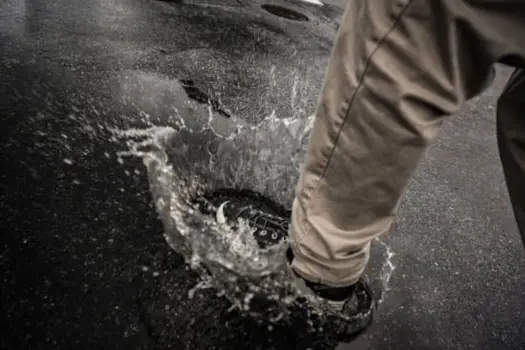
Stomping involves forcefully striking the ground with one’s foot, generating sound energy through the impact. The sound produced depends on factors such as the force applied, the surface being stomped on, and the footwear. Stomping is often used as a rhythmic and percussive element in various forms of dance, music, or even as a form of expression. The creation of sound through stomping demonstrates how kinetic energy from the body is transferred to the ground, resulting in the production of audible vibrations and sound waves.
Clapping

Clapping is a simple yet effective means of creating sound energy through the collision of hands. When hands come together, they compress the air between them, creating pressure waves that propagate as sound waves. The speed, force, and timing of the hand movements influence the pitch and volume of the resulting clapping sound. Clapping is a universal form of expressing appreciation, rhythm, and celebration, demonstrating the ease with which humans can intentionally produce sound energy through coordinated hand movements.
Crumpling

Crumpling refers to the action of wrinkling or compressing a material, such as paper or plastic. When an object is crumpled, the collision and deformation of the material generate sound energy. The crinkling, crackling, or crunching sounds result from the friction between the material’s surfaces and the release of internal stresses. The intensity and pitch of the crumpling sound depend on factors such as the type of material, its flexibility, and the force applied during the crumpling process. Crumpling showcases the conversion of mechanical energy into sound energy through the manipulation of materials.
Guitar

A guitar is a musical instrument that produces sound energy through the vibration of strings. When a guitarist plucks or strums the strings, they set the strings into motion, creating vibrations. These vibrations travel through the guitar’s body and are transmitted to the air as sound waves. The guitar’s hollow body amplifies the sound, and the pitch and tone can be altered by pressing strings against frets. The skilled manipulation of strings and frets allows musicians to produce a wide range of musical notes and expressiveness, showcasing the intentional creation of sound energy in the form of music.
Window curtain

A window curtain can generate sound energy when moved or manipulated. The rustling or swishing sound occurs as the fabric of the curtain interacts with the air. When the curtain is opened or closed, the movement of the fabric creates vibrations that propagate through the air as sound waves. The specific sound profile may vary based on the material, thickness, and texture of the curtain. Window curtains unintentionally illustrate the conversion of mechanical energy (from the movement of the curtain) into sound energy, adding an auditory aspect to the visual act of adjusting window coverings.
Traffic collision

A traffic collision generates sound energy as a result of the impact between two or more vehicles. When vehicles collide, the kinetic energy of the moving objects is suddenly transformed into other forms of energy, including sound energy. The crashing, screeching, or banging sounds produced during a collision are manifestations of the forces and structural deformations involved. The intensity and type of sound may vary depending on factors such as the speed of the vehicles, the angle of impact, and the materials involved. Traffic collisions unintentionally demonstrate the transformation of kinetic energy into sound energy during moments of impact.
Nose-blowing

Nose-blowing produces sound energy as a result of the forceful expulsion of air through the nasal passages. When someone blows their nose, the rush of air causes vibrations in the surrounding tissues, creating sound waves. The pitch and intensity of the sound depend on factors such as the force of the blow and the individual’s anatomy. While primarily a practical action for clearing nasal passages, nose-blowing unintentionally demonstrates the generation of sound energy through the movement of air.
Tap dance
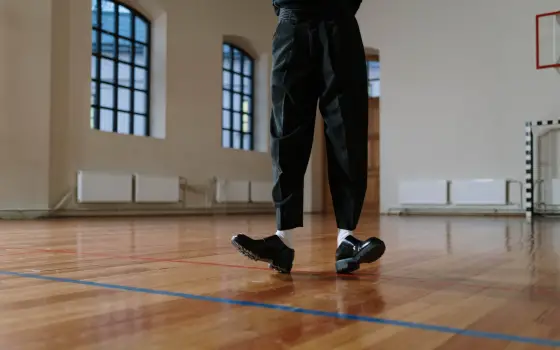
Tap dance is a form of dance that creates sound energy through rhythmic and percussive footwork. Dancers wear shoes with metal plates on the soles, and as they strike the floor with varying degrees of force and precision, the metal plates produce distinctive tapping sounds. The intricate footwork, syncopation, and improvisation in tap dance highlight the intentional creation of sound energy as an integral part of the performance. Tap dancers skillfully utilize their feet to generate complex and expressive rhythms, showcasing the artistic fusion of movement and sound.
Grilling

Grilling chicken generates sound energy during the cooking process, particularly when using open flames or a barbecue grill. As chicken is placed on the grill, the sizzling and crackling sounds are produced due to the moisture in the chicken coming into contact with the hot grill grates or open flames. The intense heat causes water to rapidly evaporate, creating audible steam and hissing sounds. The grilling process exemplifies the conversion of thermal energy into sound energy as the chicken cooks and develops a flavorful crust. The sound produced is not only a byproduct of cooking but also adds to the sensory experience of outdoor grilling.
Radio

Radios produce sound energy as they receive and amplify radio waves to broadcast audio content. When a radio is tuned to a specific frequency, the radio’s antenna captures electromagnetic waves carrying radio signals. These signals are then converted into electrical signals and amplified by the radio’s circuits. The final step involves the conversion of electrical signals back into sound waves through a speaker. The resulting sound energy is heard as music, speech, or other audio content. Radios showcase the intentional conversion of electromagnetic energy into sound energy, allowing users to enjoy various forms of auditory entertainment.
Television

Televisions produce sound energy as part of the overall audio-visual experience. When a television is turned on, an electrical signal carrying audio information is processed by internal circuits. The processed signal is then sent to built-in speakers or external audio devices, where it is converted into sound waves. The sound energy produced complements the visual content, enhancing the viewer’s overall experience. Whether it’s dialogue, background music, or sound effects, televisions showcase the intentional integration of sound energy to provide a comprehensive audio-visual presentation in various forms of entertainment.
Speaker

A loudspeaker, or speaker, is a device designed to convert electrical signals into sound waves. When an electrical audio signal is sent to the loudspeaker, a diaphragm within the speaker vibrates rapidly. These vibrations create changes in air pressure, producing sound waves that correspond to the original audio signal. The resulting sound energy is then emitted through the speaker cone. Loudspeakers are integral components in audio systems, ranging from music playback to public address systems, illustrating the intentional conversion of electrical energy into sound energy for various applications.
Air conditioning
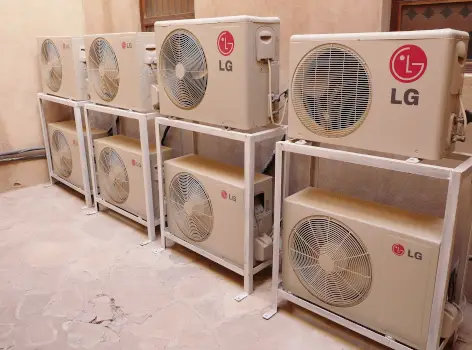
Air conditioning systems generate sound energy during their operation, primarily through the mechanical components responsible for cooling. When an air conditioner is turned on, an electric motor drives a compressor and a fan. The compressor pressurizes and circulates refrigerant, while the fan circulates air through the cooling coils. The resulting hum or whirring sound is a result of the mechanical movement of these components. The pitch and volume of the sound can vary depending on factors such as the type of air conditioning unit, its size, and the efficiency of its components. Air conditioning systems illustrate the conversion of electrical energy into mechanical and sound energy to maintain indoor comfort.
Hair dryer

A hair dryer produces sound energy as it transforms electrical energy into both thermal and kinetic energy. When a hair dryer is turned on, an electric motor drives the rotation of a fan, creating airflow. The movement of air generates a rushing or whirring sound. Simultaneously, the heating element within the hair dryer converts electrical energy into thermal energy, producing warm air. The combination of the fan’s movement and the airflow contributes to the overall sound energy produced by the hair dryer. Hair dryers showcase the intentional conversion of electrical energy into both kinetic and thermal energy for the purpose of drying and styling hair.
Vacuum cleaner

A vacuum cleaner produces sound energy during its operation, primarily from the mechanical components and the movement of air. When the vacuum cleaner is turned on, an electric motor generates suction to draw in air and particles from the surroundings. The sound is created by the rapid movement of air through the vacuum cleaner’s hoses, filters, and the noise generated by the motor and fan. The pitch and volume of the sound can vary depending on the design of the vacuum cleaner and the power of the motor. Vacuum cleaners exemplify the conversion of electrical energy into kinetic and sound energy for the purpose of cleaning.
Washing machine
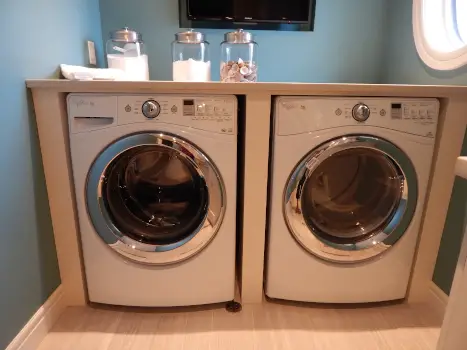
A washing machine generates sound energy during its cycles, involving the movement of water, clothes, and internal components. When a washing machine is in operation, an electric motor drives the rotation of the drum, agitating the water and clothes inside. The sloshing, splashing, and mechanical movements contribute to the overall sound produced during the washing process. The sound energy is a result of the kinetic energy involved in the rotational motion of the drum and the interactions between water and fabric. Washing machines demonstrate the conversion of electrical energy into kinetic and sound energy for the purpose of cleaning clothes.
Egg

The process of boiling an egg involves the conversion of sound energy as water transforms into steam. When an egg is placed in boiling water, the heat causes the water to reach its boiling point. As the water boils, steam bubbles rise to the surface, creating a bubbling or simmering sound. The sound energy produced is a result of the phase change from liquid to gas and the release of steam. The intensity and duration of the boiling sound depend on factors such as water temperature, egg size, and the cooking vessel. Boiling eggs illustrate the relationship between thermal energy and sound energy in the culinary process.
Fish

Frying fish generates sound energy as a result of the cooking process involving hot oil. When fish is placed in hot oil for frying, the moisture content in the fish undergoes rapid evaporation. The sizzling sound produced is a direct consequence of the water vapor escaping from the surface of the fish and interacting with the hot oil. The intensity and pitch of the sizzle can vary depending on factors such as the temperature of the oil, the size of the fish, and the cooking method. Frying fish exemplifies the conversion of thermal energy into sound energy during the culinary process.
Kettle

A kettle generates sound energy during the process of heating water. When the kettle is turned on, an electric or gas heating element rapidly heats the water inside. As the water temperature increases, bubbles form and rise to the surface, producing a characteristic bubbling or boiling sound. The sound energy is a result of the water’s transition from a liquid to a gas (steam) state and the release of steam bubbles. The pitch and intensity of the boiling sound can vary based on factors such as the heating element design, water temperature, and kettle material. Kettles showcase the conversion of thermal energy into sound energy as water reaches its boiling point.
Vehicle horn

A vehicle horn is a device designed to produce sound signals for communication, warning, or alert purposes. When the horn button is pressed, an electrical current is sent to a vibrating diaphragm or a set of vibrating reeds inside the horn. This electrical energy is converted into mechanical vibrations, causing the diaphragm or reeds to vibrate rapidly. The vibrations are then transmitted to the surrounding air as sound waves, creating the loud and distinctive honking sound. Vehicle horns demonstrate the intentional generation of sound energy for safety and communication on the road.
Photocopier

A photocopier produces sound energy during its operation through various mechanical and electrical processes. When a document is placed on the scanning bed, the photocopier uses a combination of light, lenses, and sensors to create an image of the document. The mechanical movement of internal components, such as the scanning assembly and paper feeder, generates sound waves. Additionally, the electrostatic process involved in transferring toner to the paper contributes to the overall sound produced. The hums, clicks, and whirs of a photocopier showcase the sound energy generated by the intricate interplay of mechanical and electrical components during the copying process.
Typing

Typing on a keyboard produces sound energy through the mechanical action of striking keys. When a key is pressed, it activates a mechanism that typically involves the movement of a small hammer or plunger, causing it to strike a surface or contact point beneath the key. This impact generates vibrations that propagate through the keyboard structure and into the surrounding air as sound waves. The resulting sound, often described as the “click-clack” of typing, provides valuable feedback to the typist by confirming that a key has been successfully pressed and registered. This auditory feedback contributes to the typist’s awareness and enhances the overall typing experience.
Splash

A diver’s splash into a river generates sound energy through the displacement of water and the subsequent impact with the surface. As the diver enters the water, the forceful displacement of water creates waves and ripples. The interaction between the diver’s body and the water results in sound waves traveling through both the water and the air. The sound produced is influenced by factors such as the height of the dive, the angle of entry, and the characteristics of the water. The diver’s splash exemplifies the conversion of kinetic energy from the diver’s motion into sound energy in the surrounding environment.
Car engine
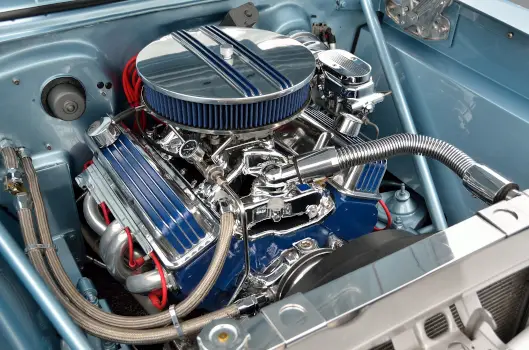
A car engine generates sound energy as a result of the combustion process within its cylinders. When fuel and air mix in the engine’s combustion chamber and ignite, the rapid expansion of gases forces the engine’s pistons into motion. This mechanical action produces vibrations that travel through the engine components and into the surrounding air. The resulting sound waves manifest as the distinctive hum, roar, or rumble characteristic of a running car engine. The specific sound profile can vary based on factors such as engine design, exhaust system, and the overall mechanical condition of the vehicle.
Aircraft engine
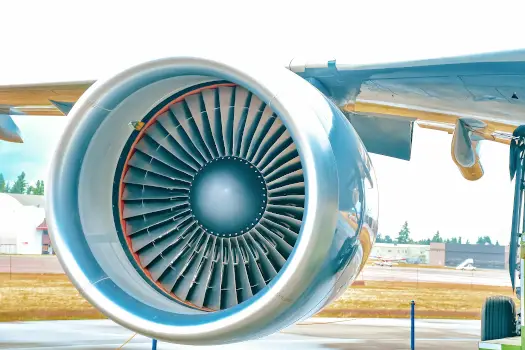
An aircraft engine, particularly jet engines, produces sound energy as a byproduct of the propulsion process. In a jet engine, air is compressed, mixed with fuel, and ignited to create a high-speed exhaust stream. The expulsion of this high-speed exhaust generates intense sound waves. The distinctive noise associated with aircraft engines during takeoff and flight is a result of the complex aerodynamic and mechanical interactions within the engine. The sound energy produced by aircraft engines is not only a characteristic feature but also a factor in aviation noise and environmental considerations.
Take off
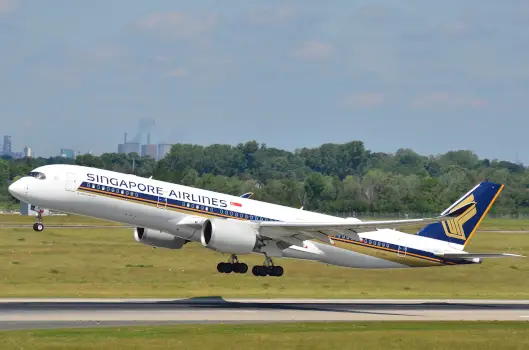
During an airplane takeoff, sound energy is produced by the powerful thrust generated by the aircraft’s engines. Jet engines, commonly used in airplanes, operate on the principle of jet propulsion. As the engines suck in air, mix it with fuel, and ignite the mixture, high-speed exhaust gases are expelled at the rear of the engine. This rapid expulsion of gases creates intense sound waves, producing the characteristic roar associated with an airplane taking off. The sound energy generated during takeoff is a result of the mechanical and aerodynamic forces at play in the propulsion system.
Crying

Crying is a human emotional expression that produces sound energy in the form of vocalizations. When an individual cries, the vocal cords in the throat vibrate as air passes through, creating sound waves. The pitch, intensity, and timbre of the crying sounds can convey a range of emotions, from sadness to joy. Crying demonstrates the intersection of emotional expression and sound production, showcasing the intentional or involuntary creation of sound energy as a means of communication and release of emotions.
Coughing

Coughing is a reflexive action that generates sound energy as a result of forceful expulsion of air from the respiratory system. When the body detects irritants or foreign particles in the airways, the cough reflex is triggered to clear the passages. The rapid release of air creates sound waves, and the resulting coughing sound can vary in intensity and frequency. Coughing serves as a protective mechanism, expelling irritants and aiding in maintaining respiratory health. The unintentional generation of sound energy during coughing illustrates the physiological response to respiratory challenges.
Laughter

Laughter is a form of vocal expression that generates sound energy through the rhythmic expulsion of air from the lungs. When a person laughs, the vocal cords vibrate, and the passage of air through the vocal tract produces sound waves. The pitch, duration, and intensity of laughter can vary widely based on individual characteristics and the emotional context. Laughter not only serves as a social and emotional cue but also exemplifies the intentional creation of sound energy through human vocalization, showcasing the intersection of physiology and emotion.
Shouting

Shouting involves projecting one’s voice with increased intensity, creating sound energy through forceful vocalization. When a person shouts, the vocal cords vibrate, and the forceful expulsion of air produces sound waves. The resulting sound can be characterized by increased volume, pitch, and intensity compared to regular speech. Shouting serves various purposes, such as communication over a distance, expressing strong emotions, or commanding attention. The intentional modulation of vocal energy in shouting highlights the dynamic nature of sound production in human communication.
Bird vocalization

Bird vocalization refers to the sounds produced by birds as a means of communication, territory marking, or mating calls. Birds generate sound energy through the movement of air across the syrinx, a specialized vocal organ found in some avian species. The variety of calls, songs, chirps, and melodies produced by birds contribute to their unique communication repertoire. Bird vocalization demonstrates how sound energy is harnessed for social interaction, navigation, and ecological interactions, showcasing the diverse ways in which birds use sound in their environments.
Singing

Singing is a form of vocal expression that involves the intentional modulation of sound energy through the vibrational activity of the vocal cords. As a person sings, the vocal cords produce varying pitches, tones, and volumes to convey musical and emotional nuances. The breath support, resonance, and articulation contribute to the creation of sound waves that are transmitted through the air. Singing is a versatile and expressive art form that highlights the deliberate manipulation of sound energy to communicate melody, lyrics, and emotions.
Slapping

Slapping refers to the action of forcefully striking one object against another, generating sound energy through impact. When an object, such as a hand or a flat surface, makes contact with another object, the collision produces vibrations that travel through both materials and the surrounding air as sound waves. The pitch and intensity of the slapping sound depend on factors such as the force applied, the materials involved, and the surface area of impact. Slapping demonstrates the direct conversion of kinetic energy from the striking object into sound energy, creating distinctive and immediate auditory feedback.
Firecracker

A firecracker is an explosive device designed to produce both light and sound energy. When ignited, the chemical compounds inside the firecracker undergo rapid combustion, creating a burst of hot gases. The expansion of gases generates shockwaves that result in the characteristic popping sound. The composition of the firecracker, including the type and amount of explosive materials, influences the pitch and intensity of the sound produced. Firecrackers are often used in celebrations and festivities to create auditory excitement, showcasing the controlled release of sound energy through explosive reactions.
Champagne toast

A champagne toast involves the clinking of glasses and the celebratory cheers accompanied by the release of carbon dioxide bubbles from the sparkling wine. The clinking of glasses creates sound energy as the glass surfaces make contact. Additionally, the popping sound produced when opening a bottle of champagne is a result of the release of pressurized gas. The collective sounds of clinking glasses and effervescence contribute to the festive and celebratory atmosphere, showcasing the combination of mechanical and gas-related processes in the creation of sound energy.
Siren

A police siren is a device used in law enforcement vehicles to produce audible signals for communication and alert purposes. The siren typically consists of a rotating or oscillating set of speakers that emit varying tones, such as wails, yelps, and sirens. These tones are created by rapidly modulating the frequency of the sound waves produced. The Doppler effect, caused by the motion of the vehicle, contributes to the changing pitch of the siren as it approaches or moves away. Police sirens showcase the intentional creation of sound energy as a vital tool for emergency response and traffic control.
Sneezing

Sneezing is a reflexive action that produces sound energy through a sudden release of air from the respiratory system. When triggered by irritants or allergens, the body responds with a forceful expulsion of air from the nose and mouth. The rushing air creates sound waves as it passes through the vocal tract and nasal passages. The sound of a sneeze is influenced by factors such as the individual’s anatomy and the force of the expulsion. Sneezing illustrates how involuntary physiological responses can generate sound energy, serving as a protective mechanism to remove irritants from the respiratory system.
Thunderstorm

A thunderstorm is a natural phenomenon that generates sound energy through a combination of lightning and atmospheric disturbances. When lightning strikes, it rapidly heats the surrounding air, causing it to expand and contract. This expansion and contraction produce shockwaves that travel through the air, resulting in the characteristic thunder sound. The intensity and duration of thunderstorms can vary, leading to a range of thunderous sounds. Thunderstorms showcase the powerful generation of sound energy in nature, emphasizing the atmospheric and electrical processes that contribute to the auditory experience of a storm.
Related
More topics
- Thermal energy
- Potential energy
- Kinetic energy
- Chemical energy
- Electrical energy
- Geothermal energy
- Radiant energy
- Sound energy
- Elastic energy
- Gravitational energy
- Mechanical energy
- Electric potential energy
- Rotational energy
- Photon energy
External links
- https://examples.yourdictionary.com/examples-of-sound-energy.html
- https://justenergy.com/blog/sound-energy-everything-you-need-to-know/
- https://www.solarschools.net/knowledge-bank/energy/types/sound
- https://www.avs4you.com/blog/sound-energy/
- https://lambdageeks.com/sound-energy-examples/
Deep
Learnool.com was founded by Deep Rana, who is a mechanical engineer by profession and a blogger by passion. He has a good conceptual knowledge on different educational topics and he provides the same on this website. He loves to learn something new everyday and believes that the best utilization of free time is developing a new skill.
